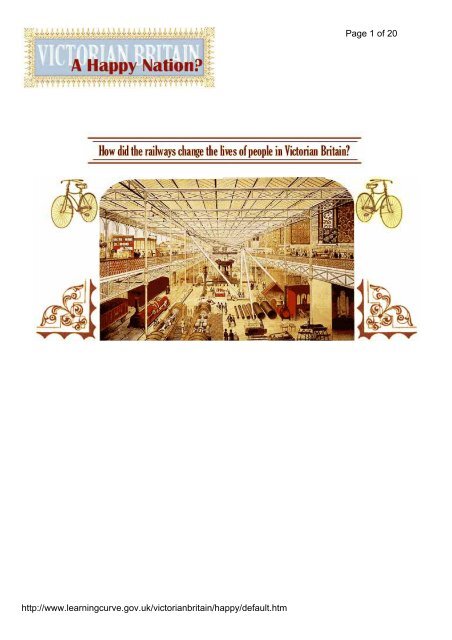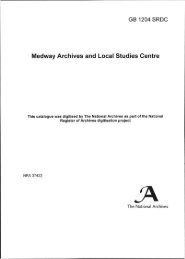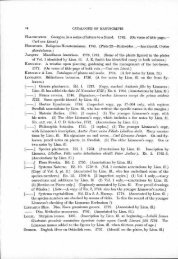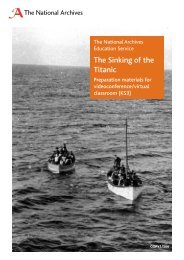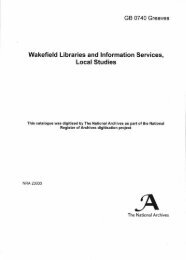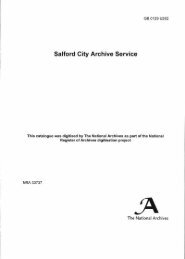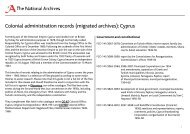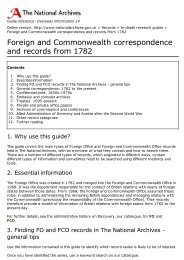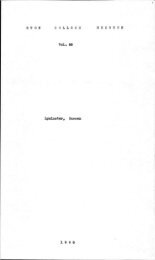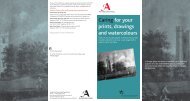http://www.learningcurve.gov.uk/victorianbritain/happy/default.htm ...
http://www.learningcurve.gov.uk/victorianbritain/happy/default.htm ...
http://www.learningcurve.gov.uk/victorianbritain/happy/default.htm ...
Create successful ePaper yourself
Turn your PDF publications into a flip-book with our unique Google optimized e-Paper software.
<strong>http</strong>://<strong>www</strong>.<strong>learningcurve</strong>.<strong>gov</strong>.<strong>uk</strong>/<strong>victorianbritain</strong>/<strong>happy</strong>/<strong>default</strong>.<strong>htm</strong><br />
Page 1 of 20
Source 1:<br />
Epsom races<br />
Source 3:<br />
Swanage seaside<br />
resort<br />
Most of the working people, who came to the Great<br />
Exhibition on the 'Shilling Days', arrived by rail, often from<br />
the north of England. King's Cross station had been opened<br />
in 1850 and there were nearly 7,000 miles of track linking<br />
London with the towns of the Midlands and the North.<br />
The most popular way of getting to the Great Exhibition was<br />
by buying a ticket that included a return rail journey and<br />
entry. These could cost 4, 5 or 6 shillings. Hundreds of<br />
thousands of people took advantage of these day trips,<br />
which were the idea of Thomas Cook.<br />
Thomas Cook started his business in 1841, but the Great<br />
Exhibition gave him his big chance.<br />
He booked trains from all over Britain to take people to the<br />
Great Exhibition and charged them a fixed price for the<br />
return trip and the entry ticket. Overnight he had invented<br />
the 'Day Out'. As Cook’s business grew he began to offer<br />
excursions to more and more places, including trips to other<br />
European countries. When Thomas Cook’s son took over<br />
the family business he increased the tours abroad and<br />
offered a wider choice of excursions. Soon the railway<br />
companies began to run their<br />
own excursions.<br />
At first, railway companies tried to avoid catering for the<br />
masses and preferred to run trains that only offered second<br />
and first class carriages. They also tried to avoid stopping<br />
their trains at every station. But in 1844 the Railways Act<br />
stated that at least one train a day must stop at every station<br />
and include third class carriages. Now large numbers of<br />
Victorians could afford to travel. Rich people could even take<br />
their horses with them on special hunting excursions!<br />
<strong>http</strong>://<strong>www</strong>.<strong>learningcurve</strong>.<strong>gov</strong>.<strong>uk</strong>/<strong>victorianbritain</strong>/<strong>happy</strong>/<strong>default</strong>.<strong>htm</strong><br />
Page 2 of 20<br />
Source 2:<br />
Great Exhibition<br />
1851<br />
Source 4<br />
Beach, Isle of<br />
Wight
Source 5:<br />
Tourist poster<br />
Source 7:<br />
Cocoa Advert<br />
The railways were to make a huge difference to the leisure<br />
activities of the Victorians. Not only were opportunities for<br />
holidays and day trips increased, sporting events also grew<br />
in popularity. Special trains and trips were run to take people<br />
to the races, cricket matches or the FA Cup Final, which was<br />
held for the first time in 1872. It was not only spectators that<br />
benefited, the football clubs that were being started in many<br />
of Britain’s Happy cities could now travel away to play<br />
against each other.<br />
In 1888 the Football League was founded. This was made<br />
up of professional teams. It would have been impossible for<br />
the first teams to have travelled to play away matches<br />
without regular trains. So the railways were very important in<br />
the development of professional football in Britain.<br />
But many of these developments only affected the better off<br />
people in Britain. For most working people, the important<br />
changes were the cheap day returns that many railway<br />
companies started to offer.<br />
In 1871 Bank Holidays were introduced and so began the<br />
great British tradition of the day at the seaside, along with<br />
sticks of rock, candy-floss, walks along the pier, fun-fair<br />
rides and fish and chips. The first fish and chip shops<br />
appeared in the 1860s.<br />
<strong>http</strong>://<strong>www</strong>.<strong>learningcurve</strong>.<strong>gov</strong>.<strong>uk</strong>/<strong>victorianbritain</strong>/<strong>happy</strong>/<strong>default</strong>.<strong>htm</strong><br />
Page 3 of 20<br />
Source 6:<br />
Footballers<br />
Source 8:<br />
Soap advert
The Railways<br />
The Victorian age was the greatest period of the railways<br />
in Britain. The railways almost completely wiped out all<br />
other forms of transport and made long distance travel<br />
possible for large numbers of people for the very first<br />
time. Every town of any importance was linked by the<br />
national network, however many smaller towns were not<br />
connected.<br />
This meant that people could, for the first time, live miles away from their places of<br />
work. Around London, suburbs began to develop for the first time and people<br />
travelled up to twenty miles in to London to work every day. Colonel Charles<br />
Sibthorp, who was a great opponent of the Crystal Palace, was also opposed to<br />
the development of railways. However, he dropped his opposition when he realised<br />
that it would be possible for him to travel to and from his constituency in Lincoln<br />
much more quickly.<br />
But people could also travel in the opposite direction and for the first time seaside<br />
resorts began to flourish. In the past, places like Brighton had only been for the<br />
wealthy, from the mid-nineteenth century more and more people were able to<br />
enjoy the delights of the seaside and a great British tradition was created.<br />
<strong>http</strong>://<strong>www</strong>.<strong>learningcurve</strong>.<strong>gov</strong>.<strong>uk</strong>/<strong>victorianbritain</strong>/<strong>happy</strong>/<strong>default</strong>.<strong>htm</strong><br />
Page 4 of 20
1a How many differences can you see between the railway carriages that the different classes of<br />
passengers used?<br />
2a What do you think was the artist’s opinion of the people in each class of carriage?<br />
3a Why do you think there are no more third class carriages on trains today?<br />
These engravings are taken from the Illustrated London News, 22nd May 1847. They show<br />
first, second and third class passengers travelling to Epsom races.<br />
<strong>http</strong>://<strong>www</strong>.<strong>learningcurve</strong>.<strong>gov</strong>.<strong>uk</strong>/<strong>victorianbritain</strong>/<strong>happy</strong>/source1.<strong>htm</strong><br />
Page 5 of 20
<strong>http</strong>://<strong>www</strong>.<strong>learningcurve</strong>.<strong>gov</strong>.<strong>uk</strong>/<strong>victorianbritain</strong>/<strong>happy</strong>/source1.<strong>htm</strong><br />
Page 6 of 20
(PRO ref: ZPER 34/10)<br />
<strong>http</strong>://<strong>www</strong>.<strong>learningcurve</strong>.<strong>gov</strong>.<strong>uk</strong>/<strong>victorianbritain</strong>/<strong>happy</strong>/source1.<strong>htm</strong><br />
Page 7 of 20
2a Can you find any evidence in the poster that different social classes were being<br />
encouraged to visit the Great Exhibition?<br />
2b Why do you think there are such differences in the prices quoted on the poster?<br />
Look back at source 1 to help you with this.<br />
2c Can you find any evidence in the poster that the safety of train travel was a concern<br />
for travellers?<br />
Poster advertising train journeys to the Great Exhibition, 1851<br />
<strong>http</strong>://<strong>www</strong>.<strong>learningcurve</strong>.<strong>gov</strong>.<strong>uk</strong>/<strong>victorianbritain</strong>/<strong>happy</strong>/source2.<strong>htm</strong><br />
Page 8 of 20
(Thomas Cook Archive)<br />
(PRO ref: 87/53)<br />
<strong>http</strong>://<strong>www</strong>.<strong>learningcurve</strong>.<strong>gov</strong>.<strong>uk</strong>/<strong>victorianbritain</strong>/<strong>happy</strong>/source2.<strong>htm</strong><br />
Page 9 of 20
3a Look at the poster carefully and describe the type of resort that you think Swanage was.<br />
Think about possible things to do and the people shown in the poster.<br />
3b Why do you think a railway company produced this poster?<br />
This poster is advertising the seaside resort of Swanage. By London & South Western<br />
Railway company. (PRO ref: COPY 1/275, f3711)<br />
<strong>http</strong>://<strong>www</strong>.<strong>learningcurve</strong>.<strong>gov</strong>.<strong>uk</strong>/<strong>victorianbritain</strong>/<strong>happy</strong>/source3.<strong>htm</strong><br />
Page 10 of 20
<strong>http</strong>://<strong>www</strong>.<strong>learningcurve</strong>.<strong>gov</strong>.<strong>uk</strong>/<strong>victorianbritain</strong>/<strong>happy</strong>/source3.<strong>htm</strong><br />
Page 11 of 20
5a Look carefully at the poster. What sorts of people would be able to go on the tours<br />
shown?<br />
5b What changes do you think have happened to Thomas Cook’s business since 1841?<br />
See if you can find at least three. You might want to read introduction text first.<br />
5c How important were the railways for Thomas Cook’s business?<br />
<strong>http</strong>://<strong>www</strong>.<strong>learningcurve</strong>.<strong>gov</strong>.<strong>uk</strong>/<strong>victorianbritain</strong>/<strong>happy</strong>/source5.<strong>htm</strong><br />
Page 12 of 20
Poster advertising some of the different tours offered by Thomas Cook<br />
(Thomas Cook Archive)<br />
<strong>http</strong>://<strong>www</strong>.<strong>learningcurve</strong>.<strong>gov</strong>.<strong>uk</strong>/<strong>victorianbritain</strong>/<strong>happy</strong>/source5.<strong>htm</strong><br />
Page 13 of 20
6a Look carefully at the photograph and the painting and list as many differences that you<br />
can think of between the footballers of 1870 and 1899.<br />
6b Now list the differences between Victorian Footballers (use the photograph) and those of<br />
today.<br />
6c What evidence is there in the photograph that football had become a popular spectator<br />
sport.<br />
6d Explain what impact the railways had on leisure activities such as watching sport.<br />
<strong>http</strong>://<strong>www</strong>.<strong>learningcurve</strong>.<strong>gov</strong>.<strong>uk</strong>/<strong>victorianbritain</strong>/<strong>happy</strong>/source6.<strong>htm</strong><br />
Page 14 of 20
6i Painting of England versus Scotland football match c.1870,<br />
Richmond Park<br />
(PRO ref: COPY 1/120)<br />
6ii Photograph of the England football team before playing against<br />
Scotland, 1899.<br />
<strong>http</strong>://<strong>www</strong>.<strong>learningcurve</strong>.<strong>gov</strong>.<strong>uk</strong>/<strong>victorianbritain</strong>/<strong>happy</strong>/source6.<strong>htm</strong><br />
Page 15 of 20
(PRO ref: COPY 1/452)<br />
<strong>http</strong>://<strong>www</strong>.<strong>learningcurve</strong>.<strong>gov</strong>.<strong>uk</strong>/<strong>victorianbritain</strong>/<strong>happy</strong>/source6.<strong>htm</strong><br />
Page 16 of 20
7a Explain what sport you think the people shown in the advertisement are taking part in.<br />
7b Why were these people shown in the advertisement?<br />
7c What does this tell us about the importance of sport to Victorians?<br />
Look carefully at the advertisement and look back at source 6<br />
7d Why do you think that Cadbury’s chose to advertise their product like this?<br />
<strong>http</strong>://<strong>www</strong>.<strong>learningcurve</strong>.<strong>gov</strong>.<strong>uk</strong>/<strong>victorianbritain</strong>/<strong>happy</strong>/source7.<strong>htm</strong><br />
Page 17 of 20
An Advert for Cadbury’s Cocoa, 1896<br />
(PRO ref: COPY 1/119, f.276)<br />
<strong>http</strong>://<strong>www</strong>.<strong>learningcurve</strong>.<strong>gov</strong>.<strong>uk</strong>/<strong>victorianbritain</strong>/<strong>happy</strong>/source7.<strong>htm</strong><br />
Page 18 of 20
8a. Why do you think Hudson’s used W.G. Grace to advertise their product?<br />
8b. Look at sources 6, 7 and 8 and explain if you think sport was popular in Victorian Britain.<br />
<strong>http</strong>://<strong>www</strong>.<strong>learningcurve</strong>.<strong>gov</strong>.<strong>uk</strong>/<strong>victorianbritain</strong>/<strong>happy</strong>/source8.<strong>htm</strong><br />
Page 19 of 20
This is an advertisement for Hudson’s washing soap. It features a famous cricketer<br />
from the Victorian Era, W. G. Grace. He began playing in 1865 and by the time he<br />
retired he had scored 54,211 runs in first class games and taken 2, 808 wickets.<br />
Grace stopped playing First Class cricket in 1908.<br />
(PRO ref: COPY 1/119, f.221)<br />
<strong>http</strong>://<strong>www</strong>.<strong>learningcurve</strong>.<strong>gov</strong>.<strong>uk</strong>/<strong>victorianbritain</strong>/<strong>happy</strong>/source8.<strong>htm</strong><br />
Page 20 of 20


